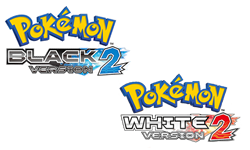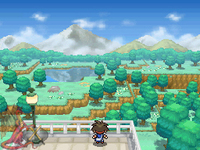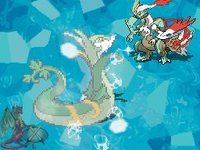|
|

|
PLATFORM
|
DS
|
BATTLE SYSTEM
|

|
INTERACTION
|

|
ORIGINALITY
|

|
STORY
|

|
MUSIC & SOUND
|

|
VISUALS
|

|
CHALLENGE
|
Moderate
|
COMPLETION TIME
|
20-40 Hours
|
|
OVERALL

|
+ Pokeyman battles are still fun.
+ The best Pokémon postgame content yet.
+ Lots of fiddly bonus material...
- ...but the core is very, very familiar.
- The story is inconsequential.
- Why not include an autorun option?
|
Click here for scoring definitions
|
|
|
Pokémon White 2 is situated in an awkward marketing category. It's mechanically more interesting than its predecessor games, Pokemon Black and White, but the changes aren't so unique the entire game doesn't feel like a retread of a retread. However, the story is a continuation of Pokémon Black and White. Players who cynically (or wisely) waited for this release to try the fifth generation Pokémon games are tossed into the middle of the Unova region's conflict with Team Plasma. After splintering two years ago, part of this band of pokémon-stealing ruffians is back to steal more pokémon. Reading a summary of the major players in Team Plasma, including Ghestis and N, is necessary to understand the politics of the major players. However, even with this background knowledge, the story's a miserable distraction from the still-entertaining gameplay. The best way to enjoy this game is to plow through the main story, defeat Unova's pokémon champion, and feast upon the abundant post-game content.
Despite the venom warranted by the central plot, Pokémon White 2 plays with time in an entertaining fashion. Because it's a direct sequel, the two-year span following Pokémon Black and White is frequently referenced. This technique allows for some entertaining narrative nods. The land of Unova feels livelier when bit characters progress through their micro-dramas between games. Accessing the Pokémon Gamelink website unlocks additional flashback vignettes. It would have been nice to see more done with this feature, since the plot is so dependent on lore from the previous titles. Rather than influencing the story, the flashbacks add to the sense of place and exploration of the environment that make up one of the continuing joys of a Pokémon title.
The environment fared better than the characters in developing and maintaining a sense of presence. The new face of the Unova region has plenty of new areas to explore. Some of the new areas are accessible by new bridges and shipping routes, while others have taken the place of zones from two years prior. In the intervening years, buildings were knocked down, tunnels were dug, and Pokémon gyms changed hands. Despite the familiarity of specific locations, the path to collect the eight Pokémon mastery badges is different. Unova has expanded in size and scope.
 It's pokémon season!
It's pokémon season!
|
|
The changing landscape continues to expand in the postgame. A barebones playthrough from the introduction to the credits misses the most interesting areas in the game. Several towns, caves, and towers that aren't accessible during the main story become unlocked following the journey's end. Arguably, this is where the real game begins since trainers now have access to a full array of options and training tools. Unlike previous Pokémon titles, enemy trainers are up to the task as well. Narratively, it's disconcerting to see bakers, preschool teachers, and small children commanding pokémon in excess of level 65. However, from a training perspective, their presence is welcome. The White Treehollow (and, presumably, the Black Tower) pit the player against high-level randomized trainers within randomly generated dungeons. Since the use of items is forbidden in these dungeons, the battles are considerably more difficult than those in the main story.
The Pokemon World Tournament exists on a similar level of difficulty. This tournament takes the place on the ruins of Driftveil City's Cold Storage. Like the Battle Subway in Nimbasa City, the Pokemon World Tournament provides Battle Points, which can be exchanged for valuable prizes. Unlike the Battle Subway, the World Tournament provides a chance to fight the gym leaders from all previous Pokémon games (including criminal mastermind, Giovanni), a different set of themed challenges, and a different Battle Point progression scheme. Defeating the postgame challenges and maintaining a strong record in the Pokemon World Tournament require careful team planning. Full IV/EV training isn't necessary, but hopping right in with the team used to breeze through the rest of the game may not work out swimmingly either.
In addition to growing larger, Unova has become more diverse in the past two years. Its pokémon trainers are more willing to endorse battle styles other than the standard 1-on-1 cockfight. Rotation and triple battles feature more prominently, as do stretches of the plot where the player teams up with an NPC trainer for double battles. Given the number of moves that function differently in team battles, it's encouraging to see the limits of the battle system more fully endorsed and explored. Unova's minigames and sidequests are likewise more interesting this time around.
While Pokéstar Studios doesn't present a viable model for running a movie studio, it's more fun than any of the previous attempts to get pokémon performing non-violently for their trainers' amusement. Each movie segment is presented as a battle. The player must perform certain moves and select fitting lines based on the demands of a vague script. Since the goal of these battles is very rarely to win as quickly as possible, getting the best possible ranking is like solving a puzzle. Initially, each script can only be attempted with a rental pokémon with a specialized move set. However, completed scripts can be retried with the trainer's own pokémon for a chance at higher scores and a sparkly battle animation. Although the movie scripts don't have too many branching paths, the plots are frequently entertaining. Moreover, not all of the star-studded jokes are as obvious as Stu Deeoh, the studio owner. Directors of particularly unmarketable films may find the name of one Mr. David Pokénch in the credits. It's times like that when movie stars can easily see themselves drinking away their wages from movies that (supposedly) made billions. Lemonade may be tasty, but if it makes up the majority of one's paychecks, someone's being taken for a ride!
Join Avenue is another new location of note in the Unova of the future. This empty shopping arcade requires visitors and services before it can turn a profit. Visitors can be picked up with WFC and through online trades, although several also arrive daily. These charming consumers can be recruited to run shops or sent to existing shops to upgrade their services. The shops offer a range of useful services, including Master Ball raffles, beauty salons to increase pokémon happiness, and dojos that provide instantaneous leveling. Each shop offers a limited number of services per day, and Join Avenue has a limited amount of real estate. Customizing it to take advantage of the good deals has something to offer casual players and diehards alike. Join Avenue strikes an effective balance between modifying the solo game and the social aspect of playing with others.
 Smugleaf is in all kinds of trouble.
Smugleaf is in all kinds of trouble.
|
|
The Medal Rally falls on the more social side of the solo/group divide. Collecting achievements can be enjoyable in a void, but for the process to really shine, other players with fewer achievements are necessary. The player with the most medals in their medal box is better at life, having accomplished more achievements. The notion is similar to the original lure of "catch[ing] 'em all," but with simulated medals. Achievements don't fit every game, but for a game like Pokémon White 2, which encourages exploration, they act like a selection of designer carrots and sticks. The game has plenty of crannies and suboptimal choices, and following through with them deserves commendation. Only the baddest of dudes would think of challenging the Elite 4 with a team of Grass-type pokémon. If any degree of heroism made sense in this crazy, mixed-up pokéworld, that would be it.
Mechanically, Pokémon White 2 is relatively unchanged from its predecessors. Certain pokémon have had their moves rebalanced, but the core rock-paper-scissors battle mechanics still rule. Important battles, particularly ones in the postgame, keep strategies from becoming too simple. Dual-type pokémon with uncommon pairings of strengths and weaknesses are common, as are versatile move sets. The greatest practical change to the system is in the use of Repel-type items. This time around, Repels and their derivatives provide a pop-up choice when they run out. All it takes to use a new one is a "yes." The joyful simplicity of this interface tweak isn't the same as clearing all the Zubats from their caves once and for all, but it's just as effective at self-regulating the encounter rate.
The music is snappy. Each town has its own theme, several of which are catchy and begging for extended listening. Unfortunately, the high quality of the newer town and battle songs make the more familiar legacy tracks stand out in contrast. The bicycle-riding song and the Pokémon Center theme, in particular, come off as grating rather than nostalgic when they interrupt a solid town groove. The visuals are an enjoyable blend of 2D sprites and 3D set pieces. Although usually unobtrusive, they steal the show when reminding the player of the scale involved in certain scenes. The Opelucid City gym and the culmination of Team Plasma's plan are standout moments worth experiencing.
Had Pokémon White 2's tweaks been merged with its parent games, it would have been great. Likewise, it would have had the chance at excellence had it taken more risks--especially with its storytelling. As it is, Pokémon White 2's the most refined edition yet of a long-running series. It's fun, but grounded in the fond repetition of nostalgia. Playing similar iterations of a game eventually takes its toll, leeching novelty from an otherwise excellent experience. The mechanics and opportunities to explore would have made this a great place for Pokémon newcomers to jump on, but the sparse plot doesn't do them any favors. Pokémaniacs have all sorts of minutiae and postgame-changing tweaks to consider. Anyone in between those two extremes is advised to ask how much they enjoy the core Pokémon experience. It's still here, but this time it has a new hat.
Review Archives
|









